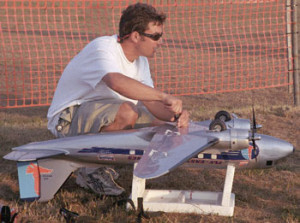Student Fellowship Awarded to Cloud Researcher

Robert Holz with a DC-3 model airplane, one of many he’s made. Holz is also a registered private pilot.
MADISON, WI, January 29, 2004—Robert Holz has been awarded the second Suomi-Simpson Graduate Fellowship. Holz is a graduate student pursuing a Ph.D. in the Department of Atmospheric and Oceanic Sciences at the University of Wisconsin–Madison. The award, named after long-time collaborators Verner Suomi and Joanne Simpson, both atmospheric scientists, enables Holz, who works with scientists in the Space Science and Engineering Center’s Cooperative Institute for Meteorological Satellite Studies (CIMSS), to collaborate with researchers in other institutions, especially NASA’s Goddard Space Flight Center (GSFC).
For the research toward his Ph.D., Holz studies the impact of clouds on climate by combining measurements of the optical properties of clouds taken by aircraft (mostly NASA’s ER-2 high-altitude aircraft) and weather satellite instruments. A difficulty in comparing measurements from multiple instruments is to determine when each instrument is pointing to the same location, known as collocating the instruments. As part of his research he will help develop software that easily enables this collocation, working with Frederick Nagle of CIMSS. According to Holz, “The advantage of working with multiple instruments is that each instrument has its individual strengths. For example, the S-HIS (Scanning-High resolution Interferometric Sounder) can measure radiation (energy) emitted from the atmosphere and Earth’s surface with very high spectral resolution, but its spatial resolution is much coarser. In contrast, the MAS (MODIS Airborne Simulator) provides very high spatial resolution but lacks the high spectral resolution of the S-HIS.” By collocating these instruments Holz can measure the spatial and spectral properties of clouds at a high resolution.
“A good analogy [to explain the difference between spatial and spectral resolution],” Holz said, “would be how your eyes perceive color. When you look at a rainbow you can see many different shades of color. The number of shades of colors that your eyes can detect would be analogous to their spectral resolution. At a very low spectral resolution your eyes would only be able to sense the difference between red, blue, and green. In reality your eyes can sense many more shades of color, or have a greater spectral resolution. Just as your eyes can sense the difference between different colors, so can the S-HIS and MAS. The spectral difference between the two instruments is that S-HIS is capable of detecting many more ‘colors’ then the MAS. However, the spatial resolution of the S-HIS is much smaller than that of MAS. In other words, the MAS can “see” more detail than the S-HIS can. Again, the eyes are a good analogy. Assuming the MAS has 20/20 vision the S-HIS might have only 20/2000 vision.”
Another example of the strengths of working with multiple instruments is the study of cloud forcing, or the net effect of clouds; i.e., whether they act to warm or cool the earth. To study cloud forcing, measurements of both their visible and infrared radiative properties are needed. The S-HIS can retrieve calibrated infrared properties of clouds while the CPL (Cloud Physics Lidar at NASA Goddard) takes accurate measurements of the visible properties of clouds. To determine how clouds affect climate, knowledge of both their visible and infrared properties is needed. By combining the CPL measurements in the visible spectrum with the S-HIS infrared measurements, he hopes to better characterize the effects of clouds on climate. At Goddard Space Flight Center, Holz will work with Matthew McGill who leads work on the Cloud Physics Lidar.
Past research experience and background
Robert Holz grew up in Ann Arbor, Michigan before attending UW–Madison to receive B.S. and M.S. (2001) degrees from the Department of Atmospheric and Oceanic Science with Professor Steven Ackerman. Working with pioneering lidar scientist Edwin Eloranta on his research thesis, he measured the optical properties of cirrus clouds (those made of ice) using a High Spectral Resolution Lidar (HSRL) developed at UW–Madison. An important result from his research was deducing the climatology of cirrus backscatter phase functions from the measurements.
The first Suomi-Simpson Fellowship was awarded to Shaima Nasiri in 2002, also to work with Goddard Space Flight Center scientists and UW–Madison’s SSEC, particularly its CIMSS, as does Robert Holz.
–T.Gregory (608-263-3373) and R.Holz (608-263-2566)
Contacts: Steven Ackerman, stevea@ssec.wisc.edu, 608-263-3647
